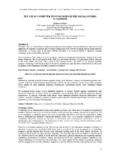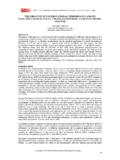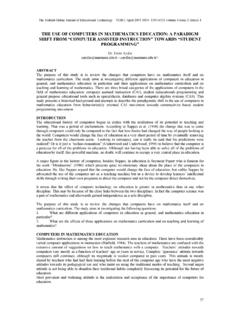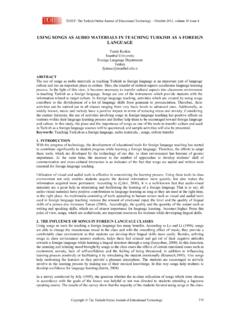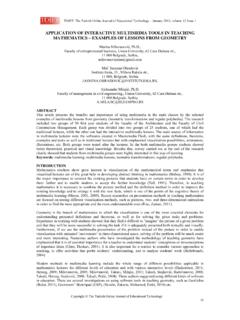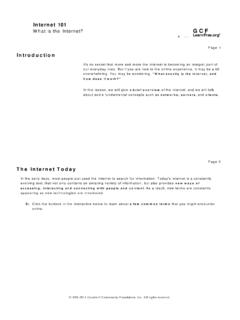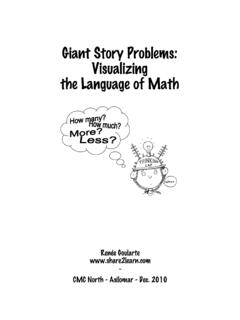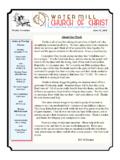Transcription of THE FACTORS THAT MOTIVATE AND HINDER THE …
1 TOJET: The Turkish Online Journal of Educational Technology October 2011, volume 10 Issue 4 Copyright The Turkish Online Journal of Educational Technology 336 THE FACTORS that MOTIVATE AND HINDER THE STUDENTS WITH HEARING IMPAIRMENT TO USE MOBILE TECHNOLOGY* Abdullah Kuzu Anadolu University Faculty of Education Department of Computer Education and Instructional Technology Eski ehir, Turkey ABSTRACT This research which aims to find out the FACTORS that MOTIVATE students with hearing impairment to use PDA (Personal Digital Assistant), a product of mobile technology, in instructional activities, interactions with their peers and instructors, and in their daily lives, and the FACTORS that HINDER these individuals from using PDA was designed as an action research. The research was conducted with 12 students with hearing impairment taking BIL151 Fundamentals of Information Technology-I course in School for the Handicapped, Department of Applied Fine Arts at Anadolu University.
2 The participants used the HP IPAO hw6915 modeled PDAs for education and social interaction purposes in the activities carried out in the scope of the research for 16 weeks. For data collection, reflections gathered with questionnaire and critic event method were employed. The quantitative data were analyzed with descriptive statistics while the qualitative data obtained from one sample t-test were analyzed with content analysis done in an inductive approach. The research was supported by TUBITAK, The Scientific and Technological Research Council of Turkey (Project Number: 107K022). This article presents the findings of the project that show the situations that MOTIVATE and HINDER students with hearing impairment to use PDA. Keywords: Mobile technologies, students with hearing impairment, motivators, barriers INTRODUCTION Children with prenatal or pre-language hearing loss face great difficulties in acquiring the speaking dimension of their mother tongue.
3 The problems in their hearing and the differences in their speech cause the children with hearing impairment not to understand talks thoroughly, reduce intelligibility of their speech, or make them totally unintelligible (Brannon, 1986; Northern and Downs 199; Osberger and Macgarr, 1982; T fek io lu, 1989). The inadequacy of the speech intelligibility in children with hearing impairment may make their communication through speech harder, and it may even cause them not to communicate at all (Kretschmer and Kretschmer, 1978; Sanders, 1971). These communication breaks of the child with hearing impairment may result in facing problems in social and emotional problems as well as problems in their future lives, education, and work (Sanders, 1971; T fek io lu, 1992). Besides face to face communication we experience through talking in our daily lives, we can feel the need to reach previous or distance information, and communicate with the people far away from us.
4 We can use tools such as telephone, fax and e-mail to meet our distance communication need. The widespread use of cell phones and their texting facility began to be an alternative way of communication for individuals with hearing impairment. However, the importance of reading and writing, another dimension of oral communication is undeniable for the individuals with hearing impairment to use distance communication tools. In this sense, mobile technology environments that offer opportunities of teaching and learning free from time and place serve as a very effective option for the education of children with hearing impairment. However, concerning the effective use of above mentioned distant communication tools, the importance of reading and writing, which are the other dimensions of oral communication, is undeniable for the individuals with hearing impairment.
5 As a result of the civilization of the humankind, the written discourse becomes more popular means of communication. Today, the increase in the publication of books, journals/magazines and similar written media as well as wide spread use of Internet ease the availability of information which in turn contribute to the rapid development of the civilizations. By means of written media and computer environments, the written discourse not only provide communication but also ease to access the information and convey this information to our next generations. Beyond all question, students with hearing impairment continuously need some innovative approaches and methods which might have an effect on their cognitive and socio-emotional * This study is a part of TUBITAK Project (Project No: 107K022) entitled Mobile Technologies in the Education of Hearing Impaired Individuals [ itme Engelli Bireylerin E itiminde Mobil Teknolojiler ( BEM)].
6 TOJET: The Turkish Online Journal of Educational Technology October 2011, volume 10 Issue 4 Copyright The Turkish Online Journal of Educational Technology 337developments as well as their academic achievements. In this respect, the mobile technologies, which provide learning and teaching opportunities without any time and place limitations, come to scene as a significant educational tool/option in the education of the students with hearing impairment. The rapid developments in the information and communication technologies accompanied various vital opportunities for the constituents the information society. Considering the daily life dynamics of the modern societies, it can be claimed that accessing to the sources of information without any time and place limitations and communicating with others become an essential need of individuals.
7 The common ground of such a consideration, which was handled within the technological frame of accessing information and establishing communication, is the Internet technologies. The Internet provides very fruitful opportunities for learners and teachers in the information societies where the concepts such as lifelong learning and time and place independent learning are on the rise. The mobile technology concept is generally used to refer to mobile information-communication tools and standards such as cell phones and PDAs (Personal Digital Assistant) ( uhadar and Odaba , 2004). Since the mobile devices are portable, ubiquitous and easily accessible, many people use them for different purposes, especially for enhancing the learning with mobile devices ( zdamar Keskin and Metcalf, 2011). The small size properties of the mobile technologies enable the individuals to carry those tools while they are maintaining their daily life activities.
8 Similarly, a new concept called m-learning , namely, mobile e-learning appeared in literature with instructional use of these tools which are easy to carry in daily life activities, and suitable for wireless communication. There are various definitions of the m-learning in the literature. For instance, while Quinn (2000) defined it as an e-learning activity that can be facilitated through portable computers, Fagerberg, Rekkaedal and Russell (2002) defined it as the use of mobile technologies in the world of education. Similarly, Georgiev, Georgieva and Smrikarov (2004) defined m-learning as the new form of existing e-learning and distant learning applications. The common point of these definitions is originated from the fact that the content of learning is transmitted to the learners through wireless networks by means of mobile instruments (Al-fahad, 2009; Odaba 2009).
9 Learners can interact with their peers either on the course related or on extracurricular subjects without any time and place limitations in student center m-learning applications where PDAs are used. One of the important contributions of PDAs, which are used for the purpose of education, is that , they could prolong the teacher-student or student-student discussions that occur during the class hours to the post lesson sessions through using various Internet tools such as blogs, discussion forums or chat rooms. The PDAs could be used at any time by the teachers for feedback purposes, since they provide communication without any time and place limitations and include various communication means such as e-mail, voice call, and SMS (short message), etc. Similarly, PDAs also enable students to ask questions to their teachers or friends and get answers to their questions whenever and wherever they want.
10 Furthermore, since PDAs have Internet access in and out off the school contexts, they could also enable the use of Web-based applications in the courses. The interactive Web pages, which are also called blogs, can be used to provide social interaction among the students and to provide learners a richer interaction environment with other stakeholders. Recent educational studies and theories that focus on blogs highlight the importance of social interaction in the field of teaching and learning (Ferdig and Trammell, 2004). Although PDAs are assumed as tools that can fill an important gap in education and social interaction areas of both hearing and hearing impaired students, this function of technology can only be fulfilled when individuals with hearing impairment accept and use mobile technologies. It is supposed that recognition of the possible FACTORS that can MOTIVATE or HINDER individuals with hearing impairment to use mobile technologies for instructional and social interaction purposes, or organizing the learning environments so as to solve the possible problems, might lead acceptance of the technology and motivation for their use by the hearing impaired individuals.
